It was interesting to see the Unity talks by Ted Gould at SCaLE9x last month, but I have to admit I’ve never really put much practical thought into UI design for touchscreen devices. I am not even a huge fan of the mouse, a touchscreen beyond that of my phone is that much worse! However, in the past week I’ve gotten to play with two touchscreen devices.
The first was at BerkeleyLUG where Jack Deslippe had one of the new Motorola Xooms running Android (the first device with Honeycomb!). On Wednesday I was at the Noisebridge Linux Discussion Night and I got to see the ExoPC Slate running Ubuntu 10.10, and took a couple pictures while we were booting it up after a fix to grub:
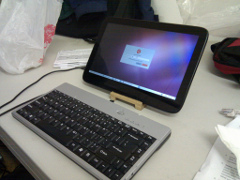
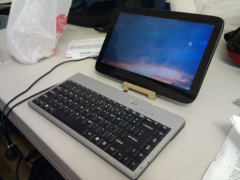
I have to say that while it was cool to see Gnome on a tablet, navigation wasn’t optimal. For the first time I really saw a place for the Unity interface, and while I still am skeptical about the decision to make it the default interface for 11.04, I am now excited about the direction the interface is taking Ubuntu in this world which has gone so mobile and touchscreen.
It was with all these dreams of the future of UI that I reinstalled my netbook this weekend, and realized I’m still quite the traditionalist (as if saying I don’t care for mice wasn’t enough of an indicator!).
My UI adventures with Linux started from day one. My boyfriend had introduced me to Linux running on his own machines in 1999 but it wasn’t until we moved in together in 2001 that I really wanted it on my own. in early 2002 I had my first Linux install that was all my own, running RedHat 7.2 with Enlightenment. My boyfriend was a minimalist and when he gave me Enlightenment it was without icons or visible menus. I booted into Windows and asked some of my Linux friends what to do (“Enlightenment? Right click anywhere on the desktop for a menu.” “OH!”). I primarily used Enlightenment through my switch to Debian in late 2002 and through 2003.
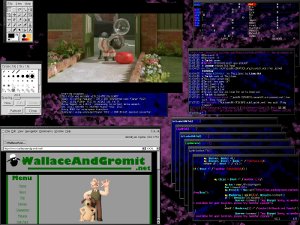
I also made a foray into Gentoo in 2003 and with it tried out Fluxbox. My love of Fluxbox has not waned over the years, I still use it today on the 2nd computer on my desk (a Debian box which runs my firewall, some Xen VMs and is plugged into my 2nd monitor for some web stuff) and on my old Debian laptop.
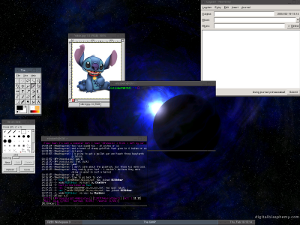
After a short stint with Window Maker, in 2004 I discovered Xfce and it was love at first configuration click. With Enlightenment and Fluxbox I had grown accustom to editing configuration files manually but it had become tedious. Xfce had the beautiful configurability of E and Flux, but simplified with configuration tools.
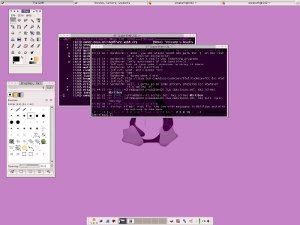
And so I happily have gone along with Xfce on my primary desktop for the past 6 years.
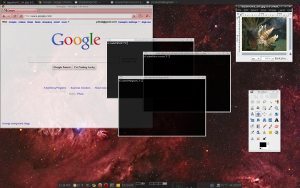
In 2008 I was given my mini9 and it shipped with 8.04 and Gnome. I’ll be honest, for all my years of Linux I’d never given Gnome a fair shot. I kept Gnome and that 8.04 stock install on my mini9 for over two years, until yesterday when I realized that the pending EOL of the 8.04 desktop edition was coming up quickly and I should take advantage of some of the down time I had this weekend. I used dd to copy the disk image to an LV on my desktop (just in case 10.04 hated my netbook!) and made the major decision to not just reinstall with stock 10.04, but to switch to Xfce4 and use the Xubuntu iso instead. Gnome had done what I needed it to do in 8.04, but the changes in 10.04 were a bit much for me and with the great support that Xfce4 has for Gnome things in the panel there wasn’t a compelling reason for me to tough it out for the benefits.

I made the right decision, I love Xfce and I’m glad to be using it on my netbook so that now my daily desktop environment and the one on my netbook are that much more in sync. Additionally, I’m delighted to report that everything on my netbook is working perfectly post upgrade. No problems with wifi, camera, special keys, suspend… I’m very happy! Hooray Xfce!


Saturday, Apr 2nd, 2011 at 19:51
What is the theme you are running under – XFCE4 on Ubuntu Desktop, July 2010 I really like the terminals. Did you use a separate setting for those?
I used to be a hardcore Enlightenment but have recently been looking at something a little easier to work with. I get so tired of building via CVS and then configuring constantly.
Thanks
Saturday, Apr 2nd, 2011 at 20:34
I’m using rxvt-unicode with default options in those screenshots and am still using it.